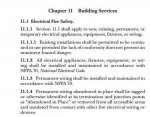You are using an out of date browser. It may not display this or other websites correctly.
You should upgrade or use an alternative browser.
You should upgrade or use an alternative browser.
exposed wires that are energized
- Thread starter wireman1
- Start date
- Status
- Not open for further replies.
mkgrady
Senior Member
- Location
- Massachusetts
You might try re-wording the question. What are you trying to figure out? You already know it would be a bad idea to have uninsulated energized wires insider outside an enclosure. And if you are replacing these wires why would the new wires not be insulated?
- Location
- Lockport, IL
- Occupation
- Semi-Retired Electrical Engineer
There is no NEC article that forbids leaving energized wires exposed where a person could come into contact with them. There is also no NEC article that forbids leaving the cover off of a panel, thus creating a danger that a person might reach in and touch a live bus bar. The NEC is not in place to combat stupidity. I think the closest you will find to what you are seeking is the "neat and workmanlike manner" statement in 110.12. But please note that it speaks of installation, not demolition.
fmtjfw
Senior Member
- Location
- Fairmont, WV, USA
what article states that energized wires that are exposed must be wrapped in tape or be placed in wire nuts and enclosed in a juction box with cover.these are often when replacing old wiring.
You need to look in 70E for such a restriction. I was pursuing a grievance against an electrician who did leave uninsulated wires exposed. We found nothing to 70, but there was something in 70E. Fortunately both were adopted into state law by reference.
- Location
- Massachusetts
I think we could argue a long time if 'terminated' covers wires that are dead ended.
I think the intent is to require a box at a dead ended conductor but I am not sure the words support that.
300.15 Boxes, Conduit Bodies, or Fittings ?Where Required.
A box shall be installed at each outlet and switch
point for concealed knob-and-tube wiring.
Fittings and connectors shall be used only with the specific
wiring methods for which they are designed and listed.
Where the wiring method is conduit, tubing, Type AC
cable, Type MC cable, Type MI cable, nonmetallic-sheathed
cable, or other cables, a box or conduit body shall be installed
at each conductor splice point, outlet point, switch point, junction
point, termination point, or pull point, unless otherwise
permitted in 300.15(A) through (L).
I think the intent is to require a box at a dead ended conductor but I am not sure the words support that.
starbolin
Senior Member
- Location
- Rancho Buenaventura, California
110.14B
"All splices and joints and the free ends of the conductors shall be covered..."
"All splices and joints and the free ends of the conductors shall be covered..."
- Location
- Tennessee NEC:2017
- Occupation
- Semi-Retired Electrician
110.14B
"All splices and joints and the free ends of the conductors shall be covered..."
That only speaks to splicing.
- Location
- Placerville, CA, USA
- Occupation
- Retired PV System Designer
You think that "free ends" only refers to parts of a splice and free (unterminated) ends of wires?
I do not read it that way unless there is "scope' that makes that clear.
I do not read it that way unless there is "scope' that makes that clear.
mgookin
Senior Member
- Location
- Fort Myers, FL
- Occupation
- Retired inspector, plans examiner & building official
- Location
- Massachusetts
110.14B
"All splices and joints and the free ends of the conductors shall be covered..."
So if I tape them I am good to go.
david
Senior Member
- Location
- Pennsylvania
what article states that energized wires that are exposed must be wrapped in tape or be placed in wire nuts and enclosed in a juction box with cover.these are often when replacing old wiring.
110.27 Guarding of Live Parts.
does not call out all that you specified but does require protection from contact
starbolin
Senior Member
- Location
- Rancho Buenaventura, California
So if I tape them I am good to go.
In a word, no. First, this is more a work safety issue vs. an NEC issue but - at the time of inspection - several sections of the code are violated by a bare conductor. If it's a cut cable then the insulation of the cable has been damaged. This would be enough to red tag the installation. Further, the the cable 'terminates' where the conductor sheath ends. Depending on the raceway or cable type this may require an enclosure. 300.15 Yes, 'terminate' merely means to-end. Since the conductor is not insulated it is not installed according to its section and thus is not now an approved cable type; except for maybe it's now knob-and-tube and still covered by 300.15. If the conductor end is in an accessible location then it is an 'outlet' and would require a recepticle box or a device enclosure.
- Location
- Bremerton, Washington
- Occupation
- Master Electrician
what article states that energized wires that are exposed must be wrapped in tape or be placed in wire nuts and enclosed in a juction box with cover.these are often when replacing old wiring.
110.8
110.12
- Location
- Tennessee NEC:2017
- Occupation
- Semi-Retired Electrician
You think that "free ends" only refers to parts of a splice and free (unterminated) ends of wires?
I do not read it that way unless there is "scope' that makes that clear.
Well in the context of this sub topic I would say yes. Since the title of (B) is "Splices"
(B) Splices.
- Status
- Not open for further replies.


